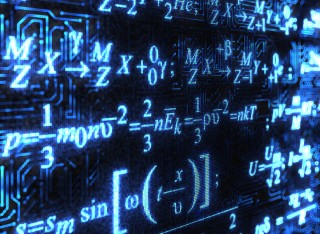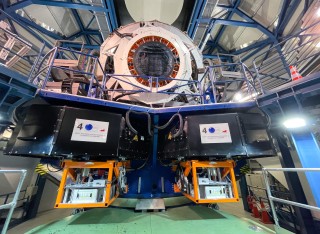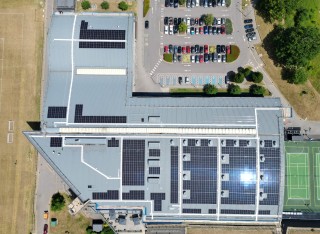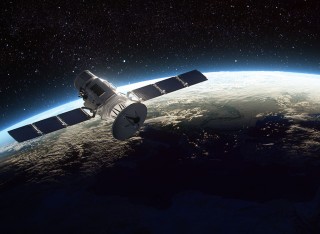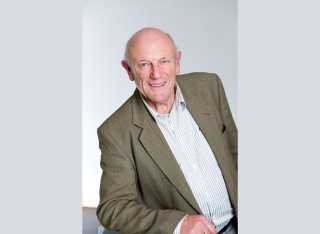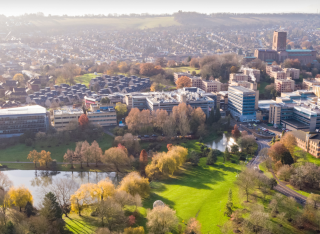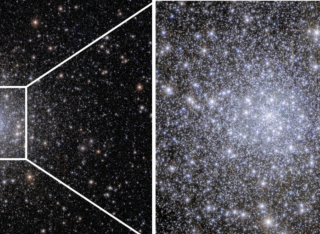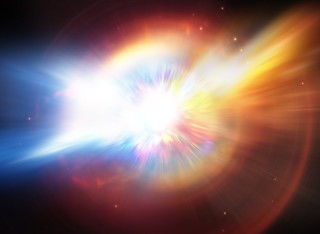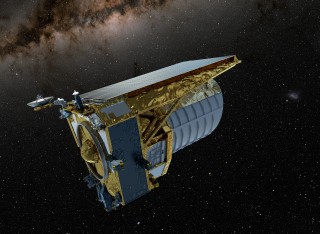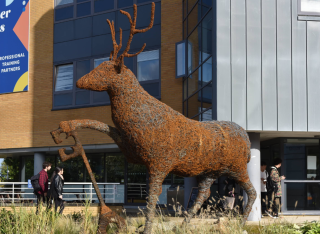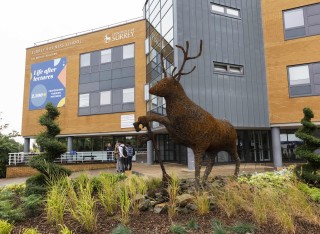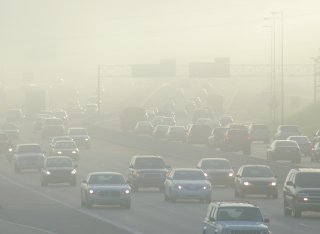
Professor Bob Nichol
About
Biography
I joined Surrey in January 2022 after 17 years at the University of Portsmouth. At Portsmouth, I was Professor of Astrophysics, Director of the Institute of Cosmology and Gravitation, and Pro Vice-Chancellor for Research, Innovation and External Relations. Prior to Portsmouth, I spent 12 years in the USA at Northwestern University, University of Chicago and Carnegie Mellon. I received my PhD from the University of Edinburgh and my degree from Manchester.
Areas of specialism
University roles and responsibilities
- Pro Vice-Chancellor
- Executive Dean
- Member of University Executive Board
- Professor of Astrophysics
- EB lead for Sustainability
News
ResearchResearch interests
My latest research is focused on the detection and characterisation of transients in large astronomical surveys. I am mostly interested in supernova explosions that can be used to measure distances in the Universe, and thus test models of cosmology. My latest experiments include Euclid and the TiDES project as part of the ESO 4MOST project. Over my career, I have been involved in a large number of astronomical surveys, with the Sloan Digital Sky Survey probably being the most famous, and having the biggest impact. I am also proud of my involvement in some great public engagement projects like GalaxyZoo and TactileUniverse. Both are amazing!
Research collaborations
A semi-exhaustive list of past and present astronomy collaborations and projects include: EDSGC, SDSS, SDSS-II, SDSS-BOSS, SDSS-IV, XCS, SHARC, 2SLAQ, DES, OzDES, DESI, Euclid, LSST, TiDES, GalaxyZoo
Indicators of esteem
- Founding member of Euclid Consortium
- Euclid Communications Lead (2011-2013)
- Spokesperson for the SDSS-III (2009-11)
- SDSS “Builder” (2000),
- SDSS-III “Architect” (2010)
- DES “Builder” (2010)
- Marie Curie Excellence Chair (2004-2007)
- American Statistical Association (ASA) prize for "Outstanding Statistical Application of the Year" (2005)
- “Breakthrough of the Year” (2003) by Science Magazine
- “EnterPrize Business Plan Competition” (2001) for DigitalMC company.
Research interests
My latest research is focused on the detection and characterisation of transients in large astronomical surveys. I am mostly interested in supernova explosions that can be used to measure distances in the Universe, and thus test models of cosmology. My latest experiments include Euclid and the TiDES project as part of the ESO 4MOST project. Over my career, I have been involved in a large number of astronomical surveys, with the Sloan Digital Sky Survey probably being the most famous, and having the biggest impact. I am also proud of my involvement in some great public engagement projects like GalaxyZoo and TactileUniverse. Both are amazing!
Research collaborations
A semi-exhaustive list of past and present astronomy collaborations and projects include: EDSGC, SDSS, SDSS-II, SDSS-BOSS, SDSS-IV, XCS, SHARC, 2SLAQ, DES, OzDES, DESI, Euclid, LSST, TiDES, GalaxyZoo
Indicators of esteem
- Founding member of Euclid Consortium
- Euclid Communications Lead (2011-2013)
- Spokesperson for the SDSS-III (2009-11)
- SDSS “Builder” (2000),
- SDSS-III “Architect” (2010)
- DES “Builder” (2010)
- Marie Curie Excellence Chair (2004-2007)
- American Statistical Association (ASA) prize for "Outstanding Statistical Application of the Year" (2005)
- “Breakthrough of the Year” (2003) by Science Magazine
- “EnterPrize Business Plan Competition” (2001) for DigitalMC company.
Supervision
Postgraduate research supervision
Harry Addison is presently working with me as a PhD student at Surrey
Teaching
In 2025, I had the pleasure to teach PHY103y ("The Universe") taking over from the amazing Jim Al-Khalili
Sustainable development goals
My research interests are related to the following:





Publications
Highlights
A full list of my publications can be found on the Astrophysics Data System (ADS). I provide a link here to (refereed) publication by "Nichol, R. C." which should be reasonably clean and complete.
Below, I provide links to ten of my favour papers (for various reasons) each have at least 150 citations. Happy to tell you why I selected them next time we meet.
- Abbott et al. 2019
- Betoule et al. 2014
- Giannantonio et al. 2008
- Masters et al. 2010
- Lampeitl et al. 2010
- York et al. 2000
- Eisenstein et al. 2005
- Baldry et al. 2004
- Bamford et al. 2009
- Bernstein et al. 1995
The Time Domain Extragalactic Survey (TiDES) conducted on the 4 m Multi-Object Spectroscopic Telescope will perform spectroscopic follow-up of extragalactic transients discovered in the era of the NSF-DOE Vera C. Rubin Observatory. TiDES will conduct a 5 yr survey, covering $\gt 14,000\,\mathrm{square}\,\mathrm{degrees}$ , and use around 250,000 fibre hours to address three main science goals: (i) spectroscopic observations of >30,000 live transients, (ii) comprehensive follow-up of >200,000 host galaxies to obtain redshift measurements, and (iii) repeat spectroscopic observations of active galactic nuclei to enable reverberation mapping studies. The live spectra from TiDES will be used to reveal the diversity and astrophysics of both normal and exotic supernovae across the luminosity-timescale plane. The extensive host-galaxy redshift campaign will allow exploitation of the larger sample of supernovae and improve photometric classification, providing the largest-ever sample of SNe Ia, capable of a sub-2% measurement of the equation-of-state of dark energy. Finally, the TiDES reverberation mapping experiment of 700–1000 AGN will complement the SN Ia sample and extend the Hubble diagram to z ∼ 2.5.
We present the full Hubble diagram of photometrically classified Type Ia supernovae (SNe Ia) from the Dark Energy Survey supernova program (DES-SN). DES-SN discovered more than 20,000 SN candidates and obtained spectroscopic redshifts of 7000 host galaxies. Based on the light-curve quality, we select 1635 photometrically identified SNe Ia with spectroscopic redshift 0.10 < z < 1.13, which is the largest sample of supernovae from any single survey and increases the number of known z > 0.5 supernovae by a factor of 5. In a companion paper, we present cosmological results of the DES-SN sample combined with 194 spectroscopically classified SNe Ia at low redshift as an anchor for cosmological fits. Here we present extensive modeling of this combined sample and validate the entire analysis pipeline used to derive distances. We show that the statistical and systematic uncertainties on cosmological parameters are 0.017 in a flat ΛCDM model, and = (0.082, 0.152) in a flat wCDM model. Combining the DES SN data with the highly complementary cosmic microwave background measurements by Planck Collaboration reduces by a factor of 4 uncertainties on cosmological parameters. In all cases, statistical uncertainties dominate over systematics. We show that uncertainties due to photometric classification make up less than 10% of the total systematic uncertainty budget. This result sets the stage for the next generation of SN cosmology surveys such as the Vera C. Rubin Observatory's Legacy Survey of Space and Time.
The correlation between the broad line region radius and continuum luminosity ($R-L$ relation) of active galactic nuclei (AGN) is critical for single-epoch mass estimates of supermassive black holes (SMBHs). At $z \sim 1-2$, where AGN activity peaks, the $R-L$ relation is constrained by the reverberation mapping (RM) lags of the Mg II line. We present 25 Mg II lags from the Australian Dark Energy Survey (OzDES) RM project based on six years of monitoring. We define quantitative criteria to select good lag measurements and verify their reliability with simulations based on both the damped random walk stochastic model and the re-scaled, re-sampled versions of the observed lightcurves of local, well-measured AGN. Our sample significantly increases the number of Mg II lags and extends the $R-L$ relation to higher redshifts and luminosities. The relative iron line strength $\mathcal{R}_{\rm Fe}$ has little impact on the $R-L$ relation. The best-fit Mg II $R-L$ relation has a slope $\alpha = 0.39 \pm 0.08$ with an intrinsic scatter $\sigma_{\rm rl} = 0.15^{+0.03}_{-0.02}$. The slope is consistent with previous measurements and shallower than the H$\beta$ $R-L$ relation. The intrinsic scatter of the new $R-L$ relation is substantially smaller than previous studies and comparable to the intrinsic scatter of the H$\beta$ $R-L$ relation. Our new $R-L$ relation will enable more precise single-epoch mass estimates and SMBH demographic studies at cosmic noon.
The correlation between the broad line region radius and continuum luminosity (R-L relation) of active galactic nuclei (AGNs) is critical for single-epoch mass estimates of supermassive black holes (SMBHs). At z similar to 1-2, where AGN activity peaks, the R-L relation is constrained by the reverberation mapping (RM) lags of the Mg II line. We present 25 Mg II lags from the Australian Dark Energy Survey RM project based on 6 yr of monitoring. We define quantitative criteria to select good lag measurements and verify their reliability with simulations based on both the damped random walk stochastic model and the rescaled, resampled versions of the observed light curves of local, well-measured AGN. Our sample significantly increases the number of Mg II lags and extends the R-L relation to higher redshifts and luminosities. The relative iron line strength R-Fe has little impact on the R-L relation. The best-fitting Mg II R-L relation has a slope alpha = 0.39 +/- 0.08 with an intrinsic scatter sigma(rl) = 0.15(-0.02)(+0.03). The slope is consistent with previous measurements and shallower than the H beta R -L relation. The intrinsic scatter of the new R-L relation is substantially smaller than previous studies and comparable to the intrinsic scatter of the H beta R-L relation. Our new R-L relation will enable more precise single-epoch mass estimates and SMBH demographic studies at cosmic noon.
Here we constrain six possible extensions to the Λ cold dark matter (CDM) model using measurements from the Dark Energy Survey’s first three years of observations, alone and in combination with external cosmological probes. The DES data are the two-point correlation functions of weak gravitational lensing, galaxy clustering, and their cross-correlation. We use simulated data vectors and blind analyses of real data to validate the robustness of our results to astrophysical and modeling systematic errors. In many cases, constraining power is limited by the absence of theoretical predictions beyond the linear regime that are reliable at our required precision. The Λ CDM extensions are dark energy with a time-dependent equation of state, nonzero spatial curvature, additional relativistic degrees of freedom, sterile neutrinos with eV-scale mass, modifications of gravitational physics, and a binned σ8(z) model which serves as a phenomenological probe of structure growth. For the time-varying dark energy equation of state evaluated at the pivot redshift we find (wp, wa) = (-0.99$^{+0.28}_{-0.17}$, -0.9 ±1.2) at 68% confidence with zp = 0.24 from the DES measurements alone, and (wp, wa) = (- 1.03$^{+0.04}_{-0.03}$, -0.4 $^{+0.4}_{-0.3)}$ with zp = 0.21 for the combination of all data considered. Curvature constraints of Ωk = 0.0009 ± 0.0017 and effective relativistic species Neff = 3.10$^{+0.15}_{-0.16}$ are dominated by external data, though adding DES information to external low-redshift probes tightens the Ωk constraints that can be made without cosmic microwave background observables by 20%. For massive sterile neutrinos, DES combined with external data improves the upper bound on the mass meff by a factor of 3 compared to previous analyses, giving 95% limits of (Δ Neff, meff) ≤ (0.28, 0.20 eV) when using priors matching a comparable Planck analysis. For modified gravity, we constrain changes to the lensing and Poisson equations controlled by functions Σ (k ,z) = Σ0ΩΛ(z)/Ω Λ,0 and μ(k, z) = μ0ΩΛ(z)/Ω Λ ,0, respectively, to Σ0 = 0.6$^{+ 0.4}_{ -0.5}$ from DES alone and (Σ0, μ0) = (0.04 ± 0.05, 0.08$^{+0.21}_{-0.19}$) for the combination of all data, both at 68% confidence. Overall, we find no significant evidence for physics beyond Λ CDM .
Early-time spectroscopy of supernovae (SNe), acquired within days of explosion, yields crucial insights into their outermost ejecta layers, facilitating the study of their environments, progenitor systems, and explosion mechanisms. Recent efforts in early discovery and follow-up of SNe have shown the potential insights that can be gained from early-time spectra. The Time-Domain Extragalactic Survey (TiDES), conducted with the 4-meter Multi-Object Spectroscopic Telescope (4MOST), will provide spectroscopic follow-up of transients discovered by the Legacy Survey of Space and Time (LSST). Current simulations indicate that early-time spectroscopic studies conducted with TiDES data will be limited by the current SN selection criteria. To enhance TiDES's capability for early-time SN spectroscopic studies, we propose an additional set of selection criteria focusing on early-time (young) SNe (YSNe). Utilising the Zwicky Transient Facility live transient alerts, we developed criteria to select YSNe while minimising the sample's contamination rate to 28 percent. The developed criteria were applied to LSST simulations, yielding a sample of 1167 Deep Drilling Field survey SNe and 67388 Wide Fast Deep survey SNe for follow-up with 4MOST. We demonstrate that our criteria enables the selection of SNe at early-times, enhancing TiDES's future early-time spectroscopic SN studies. Finally, we investigated 4MOST-like observing strategies to increase the sample of spectroscopically observed YSNe. We propose that a 4MOST-like observing strategy that follows LSST with a delay of 3 days is optimal for the TiDES SN survey, while a 1 day delay is most optimal for enhancing the early-time science in conjunction with our YSN selection criteria.
The instruments at the focus of the Euclid space observatory offer superb, diffraction-limited imaging over an unprecedented (from space) wide field of view of 0.57 deg$^2$. This exquisite image quality has the potential to produce high-precision astrometry for point sources once the undersampling of Euclid's cameras is taken into account by means of accurate, effective point spread function (ePSF) modelling. We present a complex, detailed workflow to simultaneously solve for the geometric distortion (GD) and model the undersampled ePSFs of the Euclid detectors. Our procedure was successfully developed and tested with data from the Early Release Observations (ERO) programme focused on the nearby globular cluster NGC 6397. Our final one-dimensional astrometric precision for a well-measured star just below saturation is 0.7 mas (0.007 pixel) for the Visible Instrument (VIS) and 3 mas (0.01 pixel) for the Near-Infrared Spectrometer and Photometer (NISP). Finally, we present a specific scientific application of this high-precision astrometry: the combination of Euclid and Gaia data to compute proper motions and study the internal kinematics of NGC 6397. Future work, when more data become available, will allow for a better characterisation of the ePSFs and GD corrections that are derived here, along with assessment of their temporal stability, and their dependencies on the spectral energy distribution of the sources as seen through the wide-band filters of Euclid.
The Large Synoptic Survey Telescope (LSST) Dark Energy Science Collaboration (DESC) will use five cosmological probes: galaxy clusters, large scale structure, supernovae, strong lensing, and weak lensing. This Science Requirements Document (SRD) quantifies the expected dark energy constraining power of these probes individually and together, with conservative assumptions about analysis methodology and follow-up observational resources based on our current understanding and the expected evolution within the field in the coming years. We then define requirements on analysis pipelines that will enable us to achieve our goal of carrying out a dark energy analysis consistent with the Dark Energy Task Force definition of a Stage IV dark energy experiment. This is achieved through a forecasting process that incorporates the flowdown to detailed requirements on multiple sources of systematic uncertainty. Future versions of this document will include evolution in our software capabilities and analysis plans along with updates to the LSST survey strategy.
Several investigations of the X-ray variability of active galactic nuclei (AGN) using the normalised excess variance (${\sigma^2_{\rm NXS}}$) parameter have shown that variability has a strong anti-correlation with black hole mass ($M_{\rm BH}$) and X-ray luminosity ($L_{\rm X}$). In this study we confirm these previous correlations and find no evidence of a redshift evolution. Using observations from XMM-Newton, we determine the ${\sigma^2_{\rm NXS}}$ and $L_{\rm X}$ for a sample of 1091 AGN drawn from the XMM-Newton Cluster Survey (XCS) - making this the largest study of X-ray spectral properties of AGNs. We created light-curves in three time-scales; 10 ks, 20 ks and 40 ks and used these to derive scaling relations between ${\sigma^2_{\rm NXS}}$, $L_{\rm X}$ (2.0-10 keV range) and literature estimates of $M_{\rm BH}$ from reverberation mapping. We confirm the anti-correlation between $M_{\rm BH}$ and ${\sigma^2_{\rm NXS}}$ and find a positive correlation between $M_{\rm BH}$ and $L_{\rm X}$. The use of ${\sigma^2_{\rm NXS}}$ is practical only for pointed observations where the observation time is tens of kiloseconds. For much shorter observations one cannot accurately quantify variability to estimate $M_{\rm BH}$. Here we describe a method to derive $L_{\rm X}$ from short duration observations and used these results as an estimate for $M_{\rm BH}$. We find that it is possible to estimate $L_{\rm X}$ from observations of just a few hundred seconds and that when correlated with $M_{\rm BH}$, the relation is statistically similar to the relation of $M_{\rm BH}$-$L_{\rm X}$ derived from a spectroscopic analysis of full XMM observations. This method may be particularly useful to the eROSITA mission, an all-sky survey, which will detect $>$10$^{6}$ AGN.
Phys. Rev. D 102, 023509 (2020) We perform a joint analysis of the counts and weak lensing signal of redMaPPer clusters selected from the Dark Energy Survey (DES) Year 1 dataset. Our analysis uses the same shear and source photometric redshifts estimates as were used in the DES combined probes analysis. Our analysis results in surprisingly low values for $S_8 =\sigma_8(\Omega_{\rm m}/0.3)^{0.5}= 0.65\pm 0.04$, driven by a low matter density parameter, $\Omega_{\rm m}=0.179^{+0.031}_{-0.038}$, with $\sigma_8-\Omega_{\rm m}$ posteriors in $2.4\sigma$ tension with the DES Y1 3x2pt results, and in $5.6\sigma$ with the Planck CMB analysis. These results include the impact of post-unblinding changes to the analysis, which did not improve the level of consistency with other data sets compared to the results obtained at the unblinding. The fact that multiple cosmological probes (supernovae, baryon acoustic oscillations, cosmic shear, galaxy clustering and CMB anisotropies), and other galaxy cluster analyses all favor significantly higher matter densities suggests the presence of systematic errors in the data or an incomplete modeling of the relevant physics. Cross checks with X-ray and microwave data, as well as independent constraints on the observable--mass relation from SZ selected clusters, suggest that the discrepancy resides in our modeling of the weak lensing signal rather than the cluster abundance. Repeating our analysis using a higher richness threshold ($\lambda \ge 30$) significantly reduces the tension with other probes, and points to one or more richness-dependent effects not captured by our model.
Phys. Rev. D 98, 042006 (2018) We measure the clustering of DES Year 1 galaxies that are intended to be combined with weak lensing samples in order to produce precise cosmological constraints from the joint analysis of large-scale structure and lensing correlations. Two-point correlation functions are measured for a sample of $6.6 \times 10^{5}$ luminous red galaxies selected using the \textsc{redMaGiC} algorithm over an area of $1321$ square degrees, in the redshift range $0.15 < z < 0.9$, split into five tomographic redshift bins. The sample has a mean redshift uncertainty of $\sigma_{z}/(1+z) = 0.017$. We quantify and correct spurious correlations induced by spatially variable survey properties, testing their impact on the clustering measurements and covariance. We demonstrate the sample's robustness by testing for stellar contamination, for potential biases that could arise from the systematic correction, and for the consistency between the two-point auto- and cross-correlation functions. We show that the corrections we apply have a significant impact on the resultant measurement of cosmological parameters, but that the results are robust against arbitrary choices in the correction method. We find the linear galaxy bias in each redshift bin in a fiducial cosmology to be $b(z$=$0.24)=1.40 \pm 0.08$, $b(z$=$0.38)=1.61 \pm 0.05$, $b(z$=$0.53)=1.60 \pm 0.04$ for galaxies with luminosities $L/L_*>$$0.5$, $b(z$=$0.68)=1.93 \pm 0.05$ for $L/L_*>$$1$ and $b(z$=$0.83)=1.99 \pm 0.07$ for $L/L_*$$>1.5$, broadly consistent with expectations for the redshift and luminosity dependence of the bias of red galaxies. We show these measurements to be consistent with the linear bias obtained from tangential shear measurements.
Phys. Rev. D 98, 043528 (2018) We use 26 million galaxies from the Dark Energy Survey (DES) Year 1 shape catalogs over 1321 deg$^2$ of the sky to produce the most significant measurement of cosmic shear in a galaxy survey to date. We constrain cosmological parameters in both the flat $\Lambda$CDM and $w$CDM models, while also varying the neutrino mass density. These results are shown to be robust using two independent shape catalogs, two independent \photoz\ calibration methods, and two independent analysis pipelines in a blind analysis. We find a 3.5\% fractional uncertainty on $\sigma_8(\Omega_m/0.3)^{0.5} = 0.782^{+0.027}_{-0.027}$ at 68\% CL, which is a factor of 2.5 improvement over the fractional constraining power of our DES Science Verification results. In $w$CDM, we find a 4.8\% fractional uncertainty on $\sigma_8(\Omega_m/0.3)^{0.5} = 0.777^{+0.036}_{-0.038}$ and a dark energy equation-of-state $w=-0.95^{+0.33}_{-0.39}$. We find results that are consistent with previous cosmic shear constraints in $\sigma_8$ -- $\Omega_m$, and see no evidence for disagreement of our weak lensing data with data from the CMB. Finally, we find no evidence preferring a $w$CDM model allowing $w\ne -1$. We expect further significant improvements with subsequent years of DES data, which will more than triple the sky coverage of our shape catalogs and double the effective integrated exposure time per galaxy.
We constrain extensions to the $\Lambda$CDM model using measurements from the Dark Energy Survey's first three years of observations and external data. The DES data are the two-point correlation functions of weak gravitational lensing, galaxy clustering, and their cross-correlation. We use simulated data and blind analyses of real data to validate the robustness of our results. In many cases, constraining power is limited by the absence of nonlinear predictions that are reliable at our required precision. The models are: dark energy with a time-dependent equation of state, non-zero spatial curvature, sterile neutrinos, modifications of gravitational physics, and a binned $\sigma_8(z)$ model which serves as a probe of structure growth. For the time-varying dark energy equation of state evaluated at the pivot redshift we find $(w_{\rm p}, w_a)= (-0.99^{+0.28}_{-0.17},-0.9\pm 1.2)$ at 68% confidence with $z_{\rm p}=0.24$ from the DES measurements alone, and $(w_{\rm p}, w_a)= (-1.03^{+0.04}_{-0.03},-0.4^{+0.4}_{-0.3})$ with $z_{\rm p}=0.21$ for the combination of all data considered. Curvature constraints of $\Omega_k=0.0009\pm 0.0017$ and effective relativistic species $N_{\rm eff}=3.10^{+0.15}_{-0.16}$ are dominated by external data. For massive sterile neutrinos, we improve the upper bound on the mass $m_{\rm eff}$ by a factor of three compared to previous analyses, giving 95% limits of $(\Delta N_{\rm eff},m_{\rm eff})\leq (0.28, 0.20\, {\rm eV})$. We also constrain changes to the lensing and Poisson equations controlled by functions $\Sigma(k,z) = \Sigma_0 \Omega_{\Lambda}(z)/\Omega_{\Lambda,0}$ and $\mu(k,z)=\mu_0 \Omega_{\Lambda}(z)/\Omega_{\Lambda,0}$ respectively to $\Sigma_0=0.6^{+0.4}_{-0.5}$ from DES alone and $(\Sigma_0,\mu_0)=(0.04\pm 0.05,0.08^{+0.21}_{-0.19})$ for the combination of all data. Overall, we find no significant evidence for physics beyond $\Lambda$CDM.
We characterize the X-ray luminosity--temperature ($L_{\rm X}-T$) relation using a sample of 353 clusters and groups of galaxies with temperatures in excess of 1 keV, spanning the redshift range $0.1 < z < 0.6$, the largest ever assembled for this purpose. All systems are part of the ${\it XMM-Newton}$ Cluster Survey (XCS), and have also been independently identified in Sloan Digital Sky Survey (SDSS) data using the redMaPPer algorithm. We allow for redshift evolution of the normalisation and intrinsic scatter of the $L_{\rm X}-T$ relation, as well as, for the first time, the possibility of a temperature-dependent change-point in the exponent of such relation. However, we do not find strong statistical support for deviations from the usual modelling of the $L_{\rm X}-T$ relation as a single power-law, where the normalisation evolves self-similarly and the scatter remains constant with time. Nevertheless, assuming {\it a priori} the existence of the type of deviations considered, then faster evolution than the self-similar expectation for the normalisation of the $L_{\rm X}-T$ relation is favoured, as well as a decrease with redshift in the scatter about the $L_{\rm X}-T$ relation. Further, the preferred location for a change-point is then close to 2 keV, possibly marking the transition between the group and cluster regimes. Our results also indicate an increase in the power-law exponent of the $L_{\rm X}-T$ relation when moving from the group to the cluster regime, and faster evolution in the former with respect to the later, driving the temperature-dependent change-point towards higher values with redshift.
This work focuses on the pilot run of a simulation campaign aimed at investigating the spectroscopic capabilities of the Euclid Near-Infrared Spectrometer and Photometer (NISP), in terms of continuum and emission line detection in the context of galaxy evolutionary studies. To this purpose we constructed, emulated, and analysed the spectra of 4992 star-forming galaxies at $0.3 \leq z \leq 2.5$ using the NISP pixel-level simulator. We built the spectral library starting from public multi-wavelength galaxy catalogues, with value-added information on spectral energy distribution (SED) fitting results, and from Bruzual and Charlot (2003) stellar population templates. Rest-frame optical and near-IR nebular emission lines were included using empirical and theoretical relations. We inferred the 3.5$\sigma$ NISP red grism spectroscopic detection limit of the continuum measured in the $H$ band for star-forming galaxies with a median disk half-light radius of \ang{;;0.4} at magnitude $H= 19.5\pm0.2\,$AB$\,$mag for the Euclid Wide Survey and at $H = 20.8\pm0.6\,$AB$\,$mag for the Euclid Deep Survey. We found a very good agreement with the red grism emission line detection limit requirement for the Wide and Deep surveys. We characterised the effect of the galaxy shape on the detection capability of the red grism and highlighted the degradation of the quality of the extracted spectra as the disk size increases. In particular, we found that the extracted emission line signal to noise ratio (SNR) drops by $\sim\,$45$\%$ when the disk size ranges from \ang{;;0.25} to \ang{;;1}. These trends lead to a correlation between the emission line SNR and the stellar mass of the galaxy and we demonstrate the effect in a stacking analysis unveiling emission lines otherwise too faint to detect.
Tucker et al. On 2019 August 14 at 21:10:39 UTC, the LIGO/Virgo Collaboration (LVC) detected a possible neutron star–black hole merger (NSBH), the first ever identified. An extensive search for an optical counterpart of this event, designated GW190814, was undertaken using the Dark Energy Camera on the 4 m Victor M. Blanco Telescope at the Cerro Tololo Inter-American Observatory. Target of Opportunity interrupts were issued on eight separate nights to observe 11 candidates using the 4.1 m Southern Astrophysical Research (SOAR) telescope's Goodman High Throughput Spectrograph in order to assess whether any of these transients was likely to be an optical counterpart of the possible NSBH merger. Here, we describe the process of observing with SOAR, the analysis of our spectra, our spectroscopic typing methodology, and our resultant conclusion that none of the candidates corresponded to the gravitational wave merger event but were all instead other transients. Finally, we describe the lessons learned from this effort. Application of these lessons will be critical for a successful community spectroscopic follow-up program for LVC observing run 4 (O4) and beyond. Funding for the DES Projects has been provided by the DOE and NSF(USA), MEC/MICINN/MINECO (Spain), STFC (UK), HEFCE(UK). NCSA (UIUC), KICP (U. Chicago), CCAPP (Ohio State), MIFPA (Texas A&M), CNPQ, FAPERJ, FINEP (Brazil), DFG (Germany) and the Collaborating Institutions in the Dark Energy Survey. The DES Data Management System is supported by the NSF under grant Nos. AST-1138766 and AST-1536171. The DES participants from Spanish institutions are partially supported by MINECO under grants AYA2015-71825, ESP2015-88861, FPA2015-68048, and Centro de Excelencia SEV-2016-0588, SEV-2016-0597 and MDM-2015-0509. Research leading to these results has received funding from the ERC under the EU's 7th Framework Programme including grants ERC 240672, 291329 and 306478. I.A. is a CIFAR Azrieli Global Scholar in the Gravity and the Extreme Universe Program and acknowledges support from that program, from the European Research Council (ERC) under the European Unions Horizon 2020 research and innovation program (grant agreement number 852097), from the Israel Science Foundation (grant number 2752/19), from the United States–Israel Binational Science Foundation (BSF), and from the Israeli Council for Higher Education Alon Fellowship. Peer reviewed
We present the full Hubble diagram of photometrically-classified Type Ia supernovae (SNe Ia) from the Dark Energy Survey supernova program (DES-SN). DES-SN discovered more than 20,000 SN candidates and obtained spectroscopic redshifts of 7,000 host galaxies. Based on the light-curve quality, we select 1635 photometrically-identified SNe Ia with spectroscopic redshift 0.10$< z 0.5$ supernovae by a factor of five. In a companion paper, we present cosmological results of the DES-SN sample combined with 194 spectroscopically-classified SNe Ia at low redshift as an anchor for cosmological fits. Here we present extensive modeling of this combined sample and validate the entire analysis pipeline used to derive distances. We show that the statistical and systematic uncertainties on cosmological parameters are $\sigma_{\Omega_M,{\rm stat+sys}}^{\Lambda{\rm CDM}}=$0.017 in a flat $\Lambda$CDM model, and $(\sigma_{\Omega_M},\sigma_w)_{\rm stat+sys}^{w{\rm CDM}}=$(0.082, 0.152) in a flat $w$CDM model. Combining the DES SN data with the highly complementary CMB measurements by Planck Collaboration (2020) reduces uncertainties on cosmological parameters by a factor of 4. In all cases, statistical uncertainties dominate over systematics. We show that uncertainties due to photometric classification make up less than 10% of the total systematic uncertainty budget. This result sets the stage for the next generation of SN cosmology surveys such as the Vera C. Rubin Observatory's Legacy Survey of Space and Time.
We present cosmological constraints from the sample of Type Ia supernovae (SN Ia) discovered during the full five years of the Dark Energy Survey (DES) Supernova Program. In contrast to most previous cosmological samples, in which SN are classified based on their spectra, we classify the DES SNe using a machine learning algorithm applied to their light curves in four photometric bands. Spectroscopic redshifts are acquired from a dedicated follow-up survey of the host galaxies. After accounting for the likelihood of each SN being a SN Ia, we find 1635 DES SN in the redshift range $0.10
Dusty, distant, massive ($M_*\gtrsim 10^{11}\,\rm M_\odot$) galaxies are usually found to show a remarkable star-formation activity, contributing on the order of $25\%$ of the cosmic star-formation rate density at $z\approx3$--$5$, and up to $30\%$ at $z\sim7$ from ALMA observations. Nonetheless, they are elusive in classical optical surveys, and current near-infrared surveys are able to detect them only in very small sky areas. Since these objects have low space densities, deep and wide surveys are necessary to obtain statistically relevant results about them. Euclid will be potentially capable of delivering the required information, but, given the lack of spectroscopic features at these distances within its bands, it is still unclear if it will be possible to identify and characterize these objects. The goal of this work is to assess the capability of Euclid, together with ancillary optical and near-infrared data, to identify these distant, dusty and massive galaxies, based on broadband photometry. We used a gradient-boosting algorithm to predict both the redshift and spectral type of objects at high $z$. To perform such an analysis we make use of simulated photometric observations derived using the SPRITZ software. The gradient-boosting algorithm was found to be accurate in predicting both the redshift and spectral type of objects within the Euclid Deep Survey simulated catalog at $z>2$. In particular, we study the analog of HIEROs (i.e. sources with $H-[4.5]>2.25$), combining Euclid and Spitzer data at the depth of the Deep Fields. We found that the dusty population at $3\lesssim z\lesssim 7$ is well identified, with a redshift RMS and OLF of only $0.55$ and $8.5\%$ ($H_E\leq26$), respectively. Our findings suggest that with Euclid we will obtain meaningful insights into the role of massive and dusty galaxies in the cosmic star-formation rate over time.
We present the angular diameter distance measurement obtained with the Baryonic Acoustic Oscillation feature from galaxy clustering in the completed Dark Energy Survey, consisting of six years (Y6) of observations. We use the Y6 BAO galaxy sample, optimized for BAO science in the redshift range 0.6
Current and future Type Ia Supernova (SN Ia) surveys will need to adopt new approaches to classifying SNe and obtaining their redshifts without spectra if they wish to reach their full potential. We present here a novel approach that uses only photometry to identify SNe Ia in the 5-year Dark Energy Survey (DES) dataset using the SUPERNNOVA classifier. Our approach, which does not rely on any information from the SN host-galaxy, recovers SNe Ia that might otherwise be lost due to a lack of an identifiable host. We select 2,298 high-quality SNe Ia from the DES 5-year dataset. More than 700 of these have no spectroscopic host redshift and are potentially new SNIa compared to the DES-SN5YR cosmology analysis. To analyse these SNe Ia, we derive their redshifts and properties using only their light-curves with a modified version of the SALT2 light-curve fitter. Compared to other DES SN Ia samples with spectroscopic redshifts, our new sample has in average higher redshift, bluer and broader light-curves, and fainter host-galaxies. Future surveys such as LSST will also face an additional challenge, the scarcity of spectroscopic resources for follow-up. When applying our novel method to DES data, we reduce the need for follow-up by a factor of four and three for host-galaxy and live SN respectively compared to earlier approaches. Our novel method thus leads to better optimisation of spectroscopic resources for follow-up.
We describe the first public data release of the Dark Energy Survey, DES DR1, consisting of reduced single-epoch images, co-added images, co-added source catalogs, and associated products and services assembled over the first 3 yr of DES science operations. DES DR1 is based on optical/near-infrared imaging from 345 distinct nights (2013 August to 2016 February) by the Dark Energy Camera mounted on the 4 m Blanco telescope at the Cerro Tololo Inter-American Observatory in Chile. We release data from the DES wide-area survey covering ∼5000 deg2 of the southern Galactic cap in five broad photometric bands, grizY. DES DR1 has a median delivered point-spread function of , r = 0.96, i = 0.88, z = 0.84, and Y = 0 90 FWHM, a photometric precision of
The design and analysis of time-domain sky surveys require the ability to simulate accurately realistic populations of core-collapse supernova (SN) events. We present a set of spectral time-series templates designed for this purpose, for both hydrogen-rich (Type II, IIn, and IIb) and stripped-envelope (Type Ib, Ic, and Ic-BL) core-collapse SNe. We use photometric and spectroscopic data for 67 core-collapse SNe from the literature, and for each generate a time-series spectral template. The techniques used to build the templates are fully data driven with no assumption of any parametric form or model for the light curves. The template-building code is open source, and can be applied to any transient for which well-sampled multiband photometry and multiple spectroscopic observations are available. We extend these spectral templates into the near-ultraviolet to lambda similar or equal to 1600 angstrom using observer-frame ultraviolet photometry. We also provide a set of templates corrected for host galaxy dust extinction, and provide a set of luminosity functions that can be used with our spectral templates in simulations. We give an example of how these templates can be used by integrating them within the popular SN simulation package SNANA, and simulating core-collapse SNe in photometrically selected cosmological Type Ia SN samples, prone to contamination from core-collapse events.
We present the first cosmology results from large-scale structure using the full 5000 deg(2) of imaging data from the Dark Energy Survey (DES) Data Release 1. We perform an analysis of large-scale structure combining three two-point correlation functions (3 x 2pt): (i) cosmic shear using 100 million source galaxies, (ii) galaxy clustering, and (iii) the cross-correlation of source galaxy shear with lens galaxy positions, galaxy-galaxy lensing. To achieve the cosmological precision enabled by these measurements has required updates to nearly every part of the analysis from DES Year 1, including the use of two independent galaxy clustering samples, modeling advances, and several novel improvements in the calibration of gravitational shear and photometric redshift inference. The analysis was performed under strict conditions to mitigate confirmation or observer bias; we describe specific changes made to the lens galaxy sample following unblinding of the results and tests of the robustness of our results to this decision. We model the data within the flat Lambda CDM and wCDM cosmological models, marginalizing over 25 nuisance parameters. We find consistent cosmological results between the three two-point correlation functions; their combination yields clustering amplitude S-8 = 0.776(-0.017)(+0.017) and matter density Omega(m) = 0.339(-0.031)(+0.032) in Lambda CDM, mean with 68% confidence limits; S-8 = 0.775(-0.024)(+0.026), Omega(m) = 0.352(-0.041)(+0.035), and dark energy equation-of-state parameter w = -0.98(-0.02)(+0.32) in wCDM. These constraints correspond to an improvement in signal-to-noise of the DES Year 33 x 2pt data relative to DES Year 1 by a factor of 2.1, about 20% more than expected from the increase in observing area alone. This combination of DES data is consistent with the prediction of the model favored by the Planck 2018 cosmic microwave background (CMB) primary anisotropy data, which is quantified with a probability-to-exceed p = 0.13-0.48. We find better agreement between DES 3 x 2pt and Planck than in DES Y1, despite the significantly improved precision of both. When combining DES 3 x 2pt data with available baryon acoustic oscillation, redshift-space distortion, and type la supernovae data, we find p = 0.34. Combining all of these datasets with Planck CMB lensing yields joint parameter constraints of S-8 = 0.812(-0.008)(+0.008), Omega(m) = 0.306(-0.005)(+0.004), h = 0.680(-0.003)(+0.004), and Sigma m(nu) < 0.13 eV (95% C.L.) in Lambda CDM; S-8 = 0.812(-0.008)(+0.008), Omega(m) = 0.302(-0.006)(+0.006), h = 0.687(-0.007)(+0.006), and w = -1.031(-0.027)(+0.030) in wCDM.
We define and characterize a sample of 1.3million galaxies extracted from the first year of Dark Energy Survey data, optimized to measure baryon acoustic oscillations (BAO) in the presence of significant redshift uncertainties. The sample is dominated by luminous red galaxies located at redshifts z greater than or similar to 0.6. We define the exact selection using colour and magnitude cuts that balance the need of high number densities and small photometric redshift uncertainties, using the corresponding forecasted BAO distance error as a figure-of-merit in the process. The typical photo z uncertainty varies from 2.3 per cent to 3.6 per cent (in units of 1+z) from z = 0.6 to 1, with number densities from 200 to 130 galaxies per deg(2) in tomographic bins of width Delta z = 0.1. Next, we summarize the validation of the photometric redshift estimation. We characterize and mitigate observational systematics including stellar contamination and show that the clustering on large scales is robust in front of those contaminants. We show that the clustering signal in the autocorrelations and cross-correlations is generally consistent with theoretical models, which serve as an additional test of the redshift distributions.
We present the results of a search for rapidly evolving transients in the Dark Energy Survey Supernova Programme. These events are characterized by fast light-curve evolution (rise to peak in less than or similar to 10 d and exponential decline in less than or similar to 30 d after peak). We discovered 72 events, including 37 transients with a spectroscopic redshift from host galaxy spectral features. The 37 events increase the total number of rapid optical transients by more than a factor of two. They are found at a wide range of redshifts (0.05 < z < 1.56) and peak brightnesses (-15.75 > M-g > -22.25). The multiband photometry is well fit by a blackbody up to few weeks after peak. The events appear to be hot (T approximate to 10 000-30 000 K) and large (R approximate to 10(14) -2 x 10(15) cm) at peak, and generally expand and cool in time, though some events show evidence for a receding photosphere with roughly constant temperature. Spectra taken around peak are dominated by a blue featureless continuum consistent with hot, optically thick ejecta. We compare our events with a previously suggested physical scenario involving shock breakout in an optically thick wind surrounding a core-collapse supernova, we conclude that current models for such a scenario might need an additional power source to describe the exponential decline. We find that these transients tend to favour star-forming host galaxies, which could be consistent with a core-collapse origin. However, more detailed modelling of the light curves is necessary to determine their physical origin.
Aims. The Euclid space telescope will measure the shapes and redshifts of galaxies to reconstruct the expansion history of the Universe and the growth of cosmic structures. The estimation of the expected performance of the experiment, in terms of predicted constraints on cosmological parameters, has so far relied on various individual methodologies and numerical implementations, which were developed for different observational probes and for the combination thereof. In this paper we present validated forecasts, which combine both theoretical and observational ingredients for different cosmological probes. This work is presented to provide the community with reliable numerical codes and methods for Euclid cosmological forecasts.Methods. We describe in detail the methods adopted for Fisher matrix forecasts, which were applied to galaxy clustering, weak lensing, and the combination thereof. We estimated the required accuracy for Euclid forecasts and outline a methodology for their development. We then compare and improve different numerical implementations, reaching uncertainties on the errors of cosmological parameters that are less than the required precision in all cases. Furthermore, we provide details on the validated implementations, some of which are made publicly available, in different programming languages, together with a reference training-set of input and output matrices for a set of specific models. These can be used by the reader to validate their own implementations if required.Results. We present new cosmological forecasts for Euclid. We find that results depend on the specific cosmological model and remaining freedom in each setting, for example flat or non-flat spatial cosmologies, or different cuts at non-linear scales. The numerical implementations are now reliable for these settings. We present the results for an optimistic and a pessimistic choice for these types of settings. We demonstrate that the impact of cross-correlations is particularly relevant for models beyond a cosmological constant and may allow us to increase the dark energy figure of merit by at least a factor of three.
We present a description of the Australian Dark Energy Survey (OzDES) and summarize the results from its 6 years of operations. Using the 2dF fibre positioner and AAOmega spectrograph on the 3.9-m Anglo-Australian Telescope, OzDES has monitored 771 active galactic nuclei, classified hundreds of supernovae, and obtained redshifts for thousands of galaxies that hosted a transient within the 10 deep fields of the Dark Energy Survey. We also present the second OzDES data release, containing the redshifts of almost 30 000 sources, some as faint as rAB = 24 mag, and 375 000 individual spectra. These data, in combination with the time-series photometry from the Dark Energy Survey, will be used to measure the expansion history of the Universe out to z ~ 1.2 and the masses of hundreds of black holes out to z ~ 4. OzDES is a template for future surveys that combine simultaneous monitoring of targets with wide-field imaging cameras and wide-field multi-object spectrographs.
We use stacked spectra of the host galaxies of photometrically identified Type Ia supernovae (SNe Ia) from the Dark Energy Survey (DES) to search for correlations between Hubble diagram residuals and the spectral properties of the host galaxies. Utilizing full spectrum fitting techniques on stacked spectra binned by Hubble residual, we find no evidence for trends between Hubble residuals and properties of the host galaxies that rely on spectral absorption features (
Multicomponent modeling of galaxies is a valuable tool in the effort to quantitatively understand galaxy evolution, yet the use of the technique is plagued by issues of convergence, model selection, and parameter degeneracies. These issues limit its application over large samples to the simplest models, with complex models being applied only to very small samples. We attempt to resolve this dilemma of "quantity or quality" by developing a novel framework, built inside the Zooniverse citizen-science platform, to enable the crowdsourcing of model creation for Sloan Digital Sky Survey galaxies. We have applied the method, including a final algorithmic optimization step, on a test sample of 198 galaxies, and examine the robustness of this new method. We also compare it to automated fitting pipelines, demonstrating that it is possible to consistently recover accurate models that either show good agreement with, or improve on, prior work. We conclude that citizen science is a promising technique for modeling images of complex galaxies, and release our catalog of models.
The analysis of current and future cosmological surveys of Type Ia supernovae (SNe Ia) at high redshift depends on the accurate photometric classification of the SN events detected. Generating realistic simulations of photometric SN surveys constitutes an essential step for training and testing photometric classification algorithms, and for correcting biases introduced by selection effects and contamination arising from core-collapse SNe in the photometric SN Ia samples. We use published SN time-series spectrophotometric templates, rates, luminosity functions, and empirical relationships between SNe and their host galaxies to construct a framework for simulating photometric SN surveys. We present this framework in the context of the Dark Energy Survey (DES) 5-yr photometric SN sample, comparing our simulations of DES with the observed DES transient populations. We demonstrate excellent agreement in many distributions, including Hubble residuals, between our simulations and data. We estimate the core collapse fraction expected in the DES SN sample after selection requirements are applied and before photometric classification. After testing different modelling choices and astrophysical assumptions underlying our simulation, we find that the predicted contamination varies from 7.2 to 11.7 per cent, with an average of 8.8 per cent and an r.m.s. of 1.1 per cent. Our simulations are the first to reproduce the observed photometric SN and host galaxy properties in high-redshift surveys without fine-tuning the input parameters. The simulation methods presented here will be a critical component of the cosmology analysis of the DES photometric SN Ia sample: correcting for biases arising from contamination, and evaluating the associated systematic uncertainty.
We describe the creation, content, and validation of the Dark Energy Survey (DES) internal year-one cosmology data set, Y1A1 GOLD, in support of upcoming cosmological analyses. The Y1A1 GOLD data set is assembled from multiple epochs of DES imaging and consists of calibrated photometric zero-points, object catalogs, and ancillary data products-e.g., maps of survey depth and observing conditions, star galaxy classification, and photometric redshift estimates that are necessary for accurate cosmological analyses. The Y1A1 GOLD wide area object catalog consists of similar to 137 million objects detected in co-added images covering similar to 1800 deg(2) in the DES grizY filters. The 10 sigma limiting magnitude for galaxies is g = 23.4, r = 23.2, i = 22.5, z = 21.8, and Y = 20.1. Photometric calibration of Y1A1 GOLD was performed by combining nightly zero-point solutions with stellar locus regression, and the absolute calibration accuracy is better than 2% over the survey area. DES Y1A1 GOLD is the largest photometric data set at the achieved depth to date, enabling precise measurements of cosmic acceleration at z less than or similar to 1.
We present details on the observing strategy, data-processing techniques, and spectroscopic targeting algorithms for the first three years of operation for the Dark Energy Survey Supernova Program (DES-SN). This five-year program using the Dark Energy Camera mounted on the 4 m Blanco telescope in Chile was designed to discover and follow supernovae (SNe) Ia over a wide redshift range (0.05 < z < 1.2) to measure the equation-of-state parameter of dark energy. We describe the SN program in full: strategy, observations, data reduction, spectroscopic follow-up observations, and classification. From three seasons of data, we have discovered 12,015 likely SNe, 308 of which have been spectroscopically confirmed, including 251 SNe Ia over a redshift range of 0.017 < z < 0.85. We determine the effective spectroscopic selection function for our sample and use it to investigate the redshift-dependent bias on the distance moduli of SNe Ia we have classified. The data presented here are used for the first cosmology analysis by DES-SN ("DES-SN3YR"), the results of which are given in Dark Energy Survey Collaboration et al. The 489 spectra that are used to define the DES-SN3YR sample are publicly available at https://des.ncsa.illinois.edu/releases/sn.
On 2019 August 14 at 21:10:39 UTC, the LIGO/Virgo Collaboration (LVC) detected a possible neutron star–black hole merger (NSBH), the first ever identified. An extensive search for an optical counterpart of this event, designated GW190814, was undertaken using the Dark Energy Camera on the 4 m Victor M. Blanco Telescope at the Cerro Tololo Inter-American Observatory. Target of Opportunity interrupts were issued on eight separate nights to observe 11 candidates using the 4.1 m Southern Astrophysical Research (SOAR) telescope's Goodman High Throughput Spectrograph in order to assess whether any of these transients was likely to be an optical counterpart of the possible NSBH merger. Here, we describe the process of observing with SOAR, the analysis of our spectra, our spectroscopic typing methodology, and our resultant conclusion that none of the candidates corresponded to the gravitational wave merger event but were all instead other transients. Finally, we describe the lessons learned from this effort. Application of these lessons will be critical for a successful community spectroscopic follow-up program for LVC observing run 4 (O4) and beyond.
While many studies have shown a correlation between properties of the light curves of SNe Ia and properties of their host galaxies, it remains unclear what is driving these correlations. We introduce a new direct method to study these correlations by analyzing "parent" galaxies that host multiple SNe Ia "siblings." Here, we search the Dark Energy Survey SN sample, one of the largest samples of discovered SNe, and find eight galaxies that hosted two likely SNe Ia. Comparing the light-curve properties of these SNe and recovered distances from the light curves, we find no better agreement between properties of SNe in the same galaxy as any random pair of galaxies, with the exception of the SN light-curve stretch. We show at 2.8 sigma significance that at least one-half of the intrinsic scatter of SNe Ia distance modulus residuals is not from common host properties. We also discuss the robustness with which we could make this evaluation with LSST, which will find 100x more pairs of galaxies, and pave a new line of study on the consistency of SNe Ia in the same parent galaxies. Finally, we argue that it is unlikely that some of these SNe are actually single, lensed SN with multiple images.
Euclid will be the first space mission to survey most of the extragalactic sky in the 0.95-2.02 mu m range, to a 5 sigma point-source median depth of 24.4 AB mag. This unique photometric dataset will find wide use beyond Euclid's core science. In this paper, we present accurate computations of the Euclid Y-E, J(E), and H-E passbands used by the Near-Infrared Spectrometer and Photometer (NISP), and the associated photometric system. We pay particular attention to passband variations in the field of view, accounting for, among other factors, spatially variable filter transmission and variations in the angle of incidence on the filter substrate using optical ray tracing. The response curves' cut-on and cut-off wavelengths - and their variation in the field of view - are determined with similar to 0.8 nm accuracy, essential for the photometric redshift accuracy required by Euclid. After computing the photometric zero points in the AB mag system, we present linear transformations from and to common ground-based near-infrared photometric systems, for normal stars, red and brown dwarfs, and galaxies separately. A Python tool to compute accurate magnitudes for arbitrary passbands and spectral energy distributions is provided. We discuss various factors, from space weathering to material outgassing, that may slowly alter Euclid's spectral response. At the absolute flux scale, the Euclid in-flight calibration program connects the NISP photometric system to Hubble Space Telescope spectrophotometric white dwarf standards; at the relative flux scale, the chromatic evolution of the response is tracked at the milli-mag level. In this way, we establish an accurate photometric system that is fully controlled throughout Euclid's lifetime.
We report the discovery of a new star cluster, DES 3, in the constellation of Indus, and deeper observations of the previously identified satellite DES J0222.7-5217 (Eridanus III). DES 3 was detected as a stellar overdensity in first-year Dark Energy Survey data, and confirmed with deeper photometry from the 4.1-m Southern Astrophysical Research (SOAR) telescope. The new system was detected with a relatively high significance and appears in the DES images as a compact concentration of faint blue point sources. We determine that DES 3 is located at a heliocentric distance of similar or equal to 76.2 kpc and it is dominated by an old (similar or equal to 9.8Gyr) and metal-poor ([Fe/H] similar or equal to -1.84) population. While the age and metallicity values of DES 3 are comparable to typical globular clusters (objects with a high stellar density, stellar mass of similar to 10(5) M-circle dot and luminosity M-V similar to -7.3), its half-light radius (r(h) similar to 6.87 pc) and luminosity (M-V similar to -1.7) are more indicative of faint star cluster. Based on the angular size, DES 3, with a value of r(h) similar to 0.'31, is among the smallest faint star clusters known to date. Furthermore, using deeper imaging of DES J0222.7-5217 taken with the SOAR telescope, we update structural parameters and perform the first isochrone modelling. Our analysis yields the first age (similar or equal to 12.6Gyr) and metallicity ([Fe/H] similar or equal to -2.01) estimates for this object. The half-light radius (r(h) similar or equal to 11.24 pc) and luminosity (M-V similar or equal to -2.4) of DES J0222.7-5217 suggest that it is likely a faint star cluster. The discovery of DES 3 indicates that the census of stellar systems in the Milky Way is still far from complete, and demonstrates the power of modern wide-field imaging surveys to improve our knowledge of the Galaxy's satellite population.
We propose an improved measurement of the Hubble Constant (H0) using the 'inverse distance ladder' method, which adds the information from 207 Type Ia supernovae (SNe Ia) from the Dark Energy Survey (DES) at redshift 0.018 < z < 0.85 to existing distance measurements of 122 low redshift (z < 0.07) SNe Ia (Low-z) and measurements of Baryon Acoustic Oscillations (BAOs). Whereas traditional measurements of H0 with SNe Ia use a distance ladder of parallax and Cepheid variable stars, the inverse distance ladder relies on absolute distance measurements from the BAOs to calibrate the intrinsic magnitude of the SNe Ia. We find H0 = 67.77 ± 1.3 km s-1 Mpc-1 (statistical and systematic uncertainties, 68% confidence). In this work, our measurement makes minimal assumptions about the underlying cosmological model, and our analysis was blinded to reduce confirmation bias. We investigate possible systematic uncertainties and all are presently below the statistical uncertainties. Our H0 value is consistent with estimates derived from the Cosmic Microwave Background assuming a ΔCDM universe (Planck Collaboration et al. 2018).
We present new evidence for AGN feedback in a subset of 69 quenched low-mass galaxies (M-star less than or similar to 5 x 10(9) M-circle dot, M-r > -19) selected from the first 2 yr of the Sloan Digital Sky Survey-IV Mapping Nearby Galaxies at APO (SDSS-IV MaNGA) survey. The majority (85 per cent) of these quenched galaxies appear to reside in a group environment. We find six galaxies in our sample that appear to have an active AGN that is preventing on-going star formation; this is the first time such a feedback mechanism has been observed in this mass range. Interestingly, five of these six galaxies have an ionized gas component that is kinematically offset from their stellar component, suggesting the gas is either recently accreted or outflowing. We hypothesize these six galaxies are low-mass equivalents to the 'red geysers' observed in more massive galaxies. Of the other 63 galaxies in the sample, we find 8 do appear for have some low level, residual star formation, or emission from hot, evolved stars. The remaining galaxies in our sample have no detectable ionized gas emission throughout their structures, consistent with them being quenched. This work shows the potential for understanding the detailed physical properties of dwarf galaxies through spatially resolved spectroscopy.
Cosmological analyses of samples of photometrically identified type Ia supernovae (SNe Ia) depend on understanding the effects of 'contamination' from core-collapse and peculiar SN Ia events. We employ a rigorous analysis using the photometric classifier SuperNNova on state-of-the-art simulations of SN samples to determine cosmological biases due to such 'non-Ia' contamination in the Dark Energy Survey (DES) 5-yr SN sample. Depending on the non-Ia SN models used in the SuperNNova training and testing samples, contamination ranges from 0.8 to 3.5 per cent, with a classification efficiency of 97.7-99.5 percent. Using the Bayesian Estimation Applied to Multiple Species (BEAMS) framework and its extension BBC ('BEAMS with Bias Correction'), we produce a redshift-binned Hubble diagram marginalized over contamination and corrected for selection effects, and use it to constrain the dark energy equation-of-state, w. Assuming a flat universe with Gaussian Omega(M) prior of 0.311 +/- 0.010, we show that biases on w are
We describe the derivation and validation of redshift distribution estimates and their uncertainties for the populations of galaxies used as weak-lensing sources in the Dark Energy Survey (DES) Year 1 cosmological analyses. The Bayesian Photometric Redshift (BPZ) code is used to assign galaxies to four redshift bins between z approximate to 0.2 and approximate to 1.3, and to produce initial estimates of the lensing-weighted redshift distributions n(PZ)(i)(z) proportional to d(n)(i)/dz for members of bin i. Accurate determination of cosmological parameters depends critically on knowledge of n(i), but is insensitive to bin assignments or redshift errors for individual galaxies. The cosmological analyses allow for shifts n(i)(z) = n(PZ)(i)(z - Delta z(i)) to correct the mean redshift of n(i)(z) for biases in n(PZ)(i). The Delta z(i) are constrained by comparison of independently estimated 30-band photometric redshifts of galaxies in the Cosmic Evolution Survey (COSMOS) field to BPZ estimates made from the DES griz fluxes, for a sample matched in fluxes, pre-seeing size, and lensing weight to the DES weak-lensing sources. In companion papers, the Delta z(i) of the three lowest redshift bins are further constrained by the angular clustering of the source galaxies around red galaxies with secure photometric redshifts at 0.15 < z < 0.9. This paper details the BPZ and COSMOS procedures, and demonstrates that the cosmological inference is insensitive to details of the n(i)(z) beyond the choice of Delta z(i). The clustering and COSMOS validation methods produce consistent estimates of Delta z(i) in the bins where both can be applied, with combined uncertainties of sigma(i)(Delta z) = 0.015, 0.013, 0.011, and 0.022 in the four bins. Repeating the photo-z procedure instead using the Directional Neighbourhood Fitting algorithm, or using the n(i)(z) estimated from the matched sample in COSMOS, yields no discernible difference in cosmological inferences.
Verlinde's theory of Emergent Gravity (EG) describes gravity as an emergent phenomenon rather than a fundamental force. Applying this reasoning in de Sitter space leads to gravity behaving differently on galaxy and galaxy cluster scales; this excess gravity might offer an alternative to dark matter. Here we test these ideas using the data from the Coma cluster and from 58 stacked galaxy clusters. The X-ray surface brightness measurements of the clusters at 0.1 < z < 1.2 along with the weak lensing data are used to test the theory. We find that the simultaneous EG fits of the X-ray and weak lensing datasets are significantly worse than those provided by General Relativity (with cold dark matter). For the Coma cluster, the predictions from emergent gravity and general relativity agree in the range of 250 - 700 kpc, while at around 1 Mpc scales, EG total mass predictions are larger by a factor of 2. For the cluster stack the predictions are only in good agreement at around the 1 - 2 Mpc scales, while for r greater than or similar to 10 Mpc EG is in strong tension with the data. According to the Bayesian information criterion analysis, GR is preferred in all tested datasets; however, we also discuss possible modifications of EG that greatly relax the tension with the data.
This paper describes the data release of the Sloan Digital Sky Survey-II (SDSS-II) Supernova Survey conducted between 2005 and 2007. Light curves, spectra, classifications, and ancillary data are presented for 10,258 variable and transient sources discovered through repeat ugriz imaging of SDSS Stripe 82, a 300 deg2 area along the celestial equator. This data release is comprised of all transient sources brighter than r 22.5 mag with no history of variability prior to 2004. Dedicated spectroscopic observations were performed on a subset of 889 transients, as well as spectra for thousands of transient host galaxies using the SDSS-III BOSS spectrographs. Photometric classifications are provided for the candidates with good multi-color light curves that were not observed spectroscopically, using host galaxy redshift information when available. From these observations, 4607 transients are either spectroscopically confirmed, or likely to be, supernovae, making this the largest sample of supernova candidates ever compiled. We present a new method for SN host-galaxy identification and derive host-galaxy properties including stellar masses, star formation rates, and the average stellar population ages from our SDSS multi-band photometry. We derive SALT2 distance moduli for a total of 1364 SN Ia with spectroscopic redshifts as well as photometric redshifts for a further 624 purely photometric SN Ia candidates. Using the spectroscopically confirmed subset of the three-year SDSS-II SN Ia sample and assuming a flat ΛCDM cosmology, we determine M = 0.315 0.093 (statistical error only) and detect a non-zero cosmological constant at 5.7 .
We present the first cosmological parameter constraints using measurements of type Ia supernovae (SNe Ia) from the Dark Energy Survey Supernova Program (DES-SN). The analysis uses a subsample of 207 spectroscopically confirmed SNe Ia from the first three years of DES-SN, combined with a low-redshift sample of 122 SNe from the literature. Our "DES-SN3YR" result from these 329 SNe Ia is based on a series of companion analyses and improvements covering SN Ia discovery, spectroscopic selection, photometry, calibration, distance bias corrections, and evaluation of systematic uncertainties. For a flat ΛCDM model we find a matter density . For a flat wCDM model, and combining our SN Ia constraints with those from the cosmic microwave background (CMB), we find a dark energy equation of state , and . For a flat w0waCDM model, and combining probes from SN Ia, CMB and baryon acoustic oscillations, we find and . These results are in agreement with a cosmological constant and with previous constraints using SNe Ia (Pantheon, JLA).
Using similar to 100 X-ray selected clusters in the Dark Energy Survey Science Verification data, we constrain the luminosity function ( LF) of cluster red-sequence galaxies as a function of redshift. This is the first homogeneous optical/X-ray sample large enough to constrain the evolution of the LF simultaneously in redshift ( 0.1 < z < 1.05) and cluster mass ( 13.5 <= log(10)( M-200crit) similar to< 15.0). We pay particular attention to completeness issues and the detection limit of the galaxy sample. We then apply a hierarchical Bayesian model to fit the cluster galaxy LFs via a Schechter function, including its characteristic break ( m*) to a faint end power-law slope ( alpha). Our method enables us to avoid known issues in similar analyses based on stacking or binning the clusters. We find weak and statistically insignificant (similar to 1.9 sigma) evolution in the faint end slope alpha versus redshift. We also find no dependence in alpha or m* with the X-ray inferred cluster masses. However, the amplitude of the LF as a function of cluster mass is constrained to similar to 20 per cent precision. As a by-product of our algorithm, we utilize the correlation between the LF and cluster mass to provide an improved estimate of the individual cluster masses as well as the scatter in true mass given the X-ray inferred masses. This technique can be applied to a larger sample of X-ray or optically selected clusters from the Dark Energy Survey, significantly improving the sensitivity of the analysis.
Do the theorized different formation mechanisms of fast and slow rotators produce an observable difference in their star formation histories? To study this, we identify quenching slow rotators in the MaNGA sample by selecting those that lie below the star-forming sequence and identify a sample of quenching fast rotators that were matched in stellar mass. This results in a total sample of 194 kinematically classified galaxies, which is agnostic to visual morphology. We use u - r and NUV - u colours from the Sloan Digital Sky Survey and GALEX and an existing inference package, STARPY, to conduct a first look at the onset time and exponentially declining rate of quenching of these galaxies. An Anderson-Darling test on the distribution of the inferred quenching rates across the two kinematic populations reveals they are statistically distinguishable (3.2s). We find that fast rotators quench at a much wider range of rates than slow rotators, consistent with a wide variety of physical processes such as secular evolution, minor mergers, gas accretion and environmentally driven mechanisms. Quenching is more likely to occur at rapid rates (tau less than or similar to 1Gyr) for slow rotators, in agreement with theories suggesting slow rotators are formed in dynamically fast processes, such as major mergers. Interestingly, we also find that a subset of the fast rotators quench at these same rapid rates as the bulk of the slow rotator sample. We therefore discuss how the total gas mass of a merger, rather than the merger mass ratio, may decide a galaxy's ultimate kinematic fate.
The cosmic microwave background (CMB), which permeates the entire Universe, is the radiation left over from just 380,000 years after the Big Bang. On very large scales, the CMB radiation field is smooth and isotropic, but the existence of structure in the Universe-stars, galaxies, clusters of galaxies, ... - suggests that the field should fluctuate on smaller scales. Recent observations, from the Cosmic Microwave Background Explorer to the Wilkinson Microwave Anisotropy Probe, have strikingly confirmed this prediction. CMB fluctuations provide clues to the Universe's structure and composition shortly after the Big Bang that are critical for testing cosmological models. For example, CMB data can be used to determine what portion of the Universe is composed of ordinary matter versus the mysterious dark matter and dark energy. To this end, cosmologists usually summarize the fluctuations by the power spectrum, which gives the variance as a function of angular frequency. The spectrum's shape, and in particular the location and height of its peaks, relates directly to the parameters in the cosmological models. Thus, a critical statistical question is how accurately can these peaks be estimated. We use recently developed techniques to construct a nonparametric confidence set for the unknown CMB spectrum. Our estimated spectrum, based on minimal assumptions, closely matches the model-based estimates used by cosmologists, but we can make a wide range of additional inferences. We apply these techniques to test various models and to extract confidence intervals on cosmological parameters of interest. Our analysis shows that, even without parametric assumptions, the first peak is resolved accurately with current data but that the second and third peaks are not.
ABSTRACT We present improved photometric measurements for the host galaxies of 206 spectroscopically confirmed type Ia supernovae discovered by the Dark Energy Survey Supernova Program (DES-SN) and used in the first DES-SN cosmological analysis. For the DES-SN sample, when considering a 5D (z, x1, c, α, β) bias correction, we find evidence of a Hubble residual ‘mass step’, where SNe Ia in high-mass galaxies (>1010M⊙) are intrinsically more luminous (after correction) than their low-mass counterparts by $\gamma =0.040\pm 0.019$ mag. This value is larger by 0.031 mag than the value found in the first DES-SN cosmological analysis. This difference is due to a combination of updated photometric measurements and improved star formation histories and is not from host-galaxy misidentification. When using a 1D (redshift-only) bias correction the inferred mass step is larger, with $\gamma =0.066\pm 0.020$ mag. The 1D−5D γ difference for DES-SN is $0.026\pm 0.009$ mag. We show that this difference is due to a strong correlation between host galaxy stellar mass and the x1 component of the 5D distance-bias correction. Including an intrinsic correlation between the observed properties of SNe Ia, stretch and colour, and stellar mass in simulated SN Ia samples, we show that a 5D fit recovers γ with −9 mmag bias compared to a +2 mmag bias for a 1D fit. This difference can explain part of the discrepancy seen in the data. Improvements in modelling correlations between galaxy properties and SN is necessary to ensure unbiased precision estimates of the dark energy equation of state as we enter the era of LSST.
ABSTRACT In this paper, we present the X-ray analysis of Sloan Digital Sky Survey DR8 redMaPPer (SDSSRM) clusters using data products from the XMM Cluster Survey (XCS). In total, 1189 SDSSRM clusters fall within the XMM–Newton footprint. This has yielded 456 confirmed detections accompanied by X-ray luminosity (LX) measurements. Of these clusters, 381 have an associated X-ray temperature measurement (TX). This represents one of the largest samples of coherently derived cluster TX values to date. Our analysis of the X-ray observable to richness scaling relations has demonstrated that scatter in the TX–λ relation is roughly a third of that in the LX–λ relation, and that the LX–λ scatter is intrinsic, i.e. will not be significantly reduced with larger sample sizes. Analysis of the scaling relation between LX and TX has shown that the fits are sensitive to the selection method of the sample, i.e. whether the sample is made up of clusters detected ‘serendipitously’ compared to those deliberately targeted by XMM. These differences are also seen in the LX–λ relation and, to a lesser extent, in the TX–λ relation. Exclusion of the emission from the cluster core does not make a significant impact on the findings. A combination of selection biases is a likely, but yet unproven, reason for these differences. Finally, we have also used our data to probe recent claims of anisotropy in the LX–TX relation across the sky. We find no evidence of anistropy, but stress this may be masked in our analysis by the incomplete declination coverage of the SDSS.
We aimed to develop a machine learning algorithm to predict the presence of a culprit lesion in patients with out-of-hospital cardiac arrest (OHCA). We used the King's Out-of-Hospital Cardiac Arrest Registry, a retrospective cohort of 398 patients admitted to King's College Hospital between May 2012 and December 2017. The primary outcome was the presence of a culprit coronary artery lesion, for which a gradient boosting model was optimized to predict. The algorithm was then validated in two independent European cohorts comprising 568 patients. A culprit lesion was observed in 209/309 (67.4%) patients receiving early coronary angiography in the development, and 199/293 (67.9%) in the Ljubljana and 102/132 (61.1%) in the Bristol validation cohorts, respectively. The algorithm, which is presented as a web application, incorporates nine variables including age, a localizing feature on electrocardiogram (ECG) (≥2 mm of ST change in contiguous leads), regional wall motion abnormality, history of vascular disease and initial shockable rhythm. This model had an area under the curve (AUC) of 0.89 in the development and 0.83/0.81 in the validation cohorts with good calibration and outperforms the current gold standard-ECG alone (AUC: 0.69/0.67/0/67). A novel simple machine learning-derived algorithm can be applied to patients with OHCA, to predict a culprit coronary artery disease lesion with high accuracy.
Despite vast improvements in the measurement of the cosmological parameters, the nature of dark energy and an accurate value of the Hubble constant (H0) in the Hubble-Lemaître law remain unknown. To break the current impasse, it is necessary to develop as many independent techniques as possible, such as the use of Type II supernovae (SNe II). The goal of this paper is to demonstrate the utility of SNe II for deriving accurate extragalactic distances, which will be an asset for the next generation of telescopes where more-distant SNe II will be discovered. More specifically, we present a sample from the Dark Energy Survey Supernova Program (DES-SN) consisting of 15 SNe II with photometric and spectroscopic information spanning a redshift range up to 0.35. Combining our DES SNe with publicly available samples, and using the standard candle method (SCM), we construct the largest available Hubble diagram with SNe II in the Hubble flow (70 SNe II) and find an observed dispersion of 0.27 mag. We demonstrate that adding a colour term to the SN II standardisation does not reduce the scatter in the Hubble diagram. Although SNe II are viable as distance indicators, this work points out important issues for improving their utility as independent extragalactic beacons: find new correlations, define a more standard subclass of SNe II, construct new SN II templates, and dedicate more observing time to high-redshift SNe II. Finally, for the first time, we perform simulations to estimate the redshift-dependent distance-modulus bias due to selection effects.
We consider the effects of weak gravitational lensing on observations of 196 spectroscopically confirmed Type Ia Supernovae (SNe Ia) from years 1 to 3 of the Dark Energy Survey (DES). We simultaneously measure both the angular correlation function and the non-Gaussian skewness caused by weak lensing. This approach has the advantage of being insensitive to the intrinsic dispersion of SNe Ia magnitudes. We model the amplitude of both effects as a function of sigma(8), and find sigma(8) =1.2(-0.8)(+0.9). We also apply our method to a subsample of 488 SNe from the Joint Light-curve Analysis (JLA; chosen to match the redshift range we use for this work), and find sigma(8) =0.8(-0.7)(+1.1). The comparable uncertainty in sigma(8) between DES-SN and the larger number of SNe from JLA highlights the benefits of homogeneity of the DES-SN sample, and improvements in the calibration and data analysis.
We present the analysis underpinning the measurement of cosmological parameters from 207 spectroscopically classified SNe Ia from the first 3 years of the Dark Energy Survey Supernova Program (DES-SN), spanning a redshift range of 0.017 < z < 0.849. We combine the DES-SN sample with an external sample of 122 low-redshift (z < 0.1) SNe. Ia, resulting in a "DES-SN3YR" sample of 329 SNe Ia. Our cosmological analyses are blinded: after combining our DES-SN3YR distances with constraints from the Cosmic Microwave Background, our uncertainties in the measurement of the dark energy equation-of-state parameter, w, are 0.042. (stat) and 0.059 (stat+syst) at 68% confidence. We provide a detailed systematic uncertainty budget, which has nearly equal contributions from photometric calibration, astrophysical bias corrections, and instrumental bias corrections. We also include several new sources of systematic uncertainty. While our sample is less than one-third the size of the Pantheon sample, our constraints on w are only larger by 1.4x, showing the impact of the DES-SN. Ia light-curve quality. We find that the traditional stretch and color standardization parameters of the DES-SNe. Ia are in agreement with earlier SN. Ia samples such as Pan-STARRS1 and the Supernova Legacy Survey. However, we find smaller intrinsic scatter about the Hubble diagram (0.077 mag). Interestingly, we find no evidence for a Hubble residual step (0.007 +/- 0.018 mag) as a function of host-galaxy mass for the DES subset, in 2.4 sigma tension with previous measurements. We also present novel validation methods of our sample using simulated SNe. Ia inserted in DECam images and using large catalog-level simulations to test for biases in our analysis pipelines.
We present two galaxy shape catalogues from the Dark Energy Survey Year 1 data set, covering 1500 deg(2) with a median redshift of 0.59. The catalogues cover two main fields: Stripe 82, and an area overlapping the South Pole Telescope survey region. We describe our data analysis process and in particular our shape measurement using two independent shear measurement pipelines, METACALIBRATION and IM3SHAPE. The METACALIBRATION catalogue uses a Gaussian model with an innovative internal calibration scheme, and was applied to riz bands, yielding 34.8M objects. The IM3SHAPE catalogue uses amaximum-likelihood bulge/disc model calibrated using simulations, and was applied to r-band data, yielding 21.9M objects. Both catalogues pass a suite of null tests that demonstrate their fitness for use in weak lensing science. We estimate the 1 sigma uncertainties in multiplicative shear calibration to be 0.013 and 0.025 for the METACALIBRATION and IM3SHAPE catalogues, respectively.
We present a sample of 21 hydrogen-free superluminous supernovae (SLSNe-I) and one hydrogen-rich SLSN (SLSN-II) detected during the five-year Dark Energy Survey (DES). These SNe, located in the redshift range 0.220 < z < 1.998, represent the largest homogeneously selected sample of SLSN events at high redshift. We present the observed g, r, i, z light curves for these SNe, which we interpolate using Gaussian processes. The resulting light curves are analysed to determine the luminosity function of SLSNe-I, and their evolutionary time-scales. The DES SLSN-I sample significantly broadens the distribution of SLSN-I light-curve properties when combined with existing samples from the literature. We fit a magnetar model to our SLSNe, and find that this model alone is unable to replicate the behaviour of many of the bolometric light curves. We search theDES SLSN-I light curves for the presence of initial peaks prior to the main light-curve peak. Using a shock breakout model, our Monte Carlo search finds that 3 of our 14 eventswith pre-max data display such initial peaks. However, 10 events showno evidence for such peaks, in some cases downto an absolutemagnitude of
ABSTRACT As part of the cosmology analysis using Type Ia Supernovae (SN Ia) in the Dark Energy Survey (DES), we present photometrically identified SN Ia samples using multiband light curves and host galaxy redshifts. For this analysis, we use the photometric classification framework SuperNNovatrained on realistic DES-like simulations. For reliable classification, we process the DES SN programme (DES-SN) data and introduce improvements to the classifier architecture, obtaining classification accuracies of more than 98 per cent on simulations. This is the first SN classification to make use of ensemble methods, resulting in more robust samples. Using photometry, host galaxy redshifts, and a classification probability requirement, we identify 1863 SNe Ia from which we select 1484 cosmology-grade SNe Ia spanning the redshift range of 0.07 < z < 1.14. We find good agreement between the light-curve properties of the photometrically selected sample and simulations. Additionally, we create similar SN Ia samples using two types of Bayesian Neural Network classifiers that provide uncertainties on the classification probabilities. We test the feasibility of using these uncertainties as indicators for out-of-distribution candidates and model confidence. Finally, we discuss the implications of photometric samples and classification methods for future surveys such as Vera C. Rubin Observatory Legacy Survey of Space and Time.
Using the NOvA neutrino detectors, a broad search has been performed for any signal coincident with 28 gravitational wave events detected by the LIGO/Virgo Collaboration between September 2015 and July 2019. For all of these events, NOvA is sensitive to possible arrival of neutrinos and cosmic rays of GeV and higher energies. For five (seven) events in the NOvA Far (Near) Detector, timely public alerts from the LIGO/Virgo Collaboration allowed recording of MeV-scale events. No signal candidates were found.
International audience; NASA, NSF, and DOE will collectively spend well over $4B this decade and the next on missions and surveys that have dark energy cosmology as one of their primary drivers. WFIRST, Euclid, and LSST are all missions designed to perform dedicated surveys that offer unprecedented statistical constraining power and control of systematic uncertainties. However, there is a growing realization that these missions will be significantly more powerful when the data are processed and analyzed in unison. This will require coordinated cross-survey and interagency effort. With proper attention to how data are jointly processed and analyzed, the combination of these missions will provide constraints and systematics control that is better than the sum of their individual parts, as stated in the title of Jain, et al. (2015). We advocate for the three relevant US agencies to work together with our international partners to ensure that the synergy from these multi-probe missions is fully realized.
We use numerical simulations to characterize the performance of a clustering-based method to calibrate photometric redshift biases. In particular, we cross-correlate the weak lensing source galaxies from the Dark Energy Survey Year 1 sample with redMaGiC galaxies (luminous red galaxies with secure photometric redshifts) to estimate the redshift distribution of the former sample. The recovered redshift distributions are used to calibrate the photometric redshift bias of standard photo-z methods applied to the same source galaxy sample. We apply the method to two photo-z codes run in our simulated data: Bayesian Photometric Redshift and Directional Neighbourhood Fitting. We characterize the systematic uncertainties of our calibration procedure, and find that these systematic uncertainties dominate our error budget. The dominant systematics are due to our assumption of unevolving bias and clustering across each redshift bin, and to differences between the shapes of the redshift distributions derived by clustering versus photo-zs. The systematic uncertainty in the mean redshift bias of the source galaxy sample is Delta z less than or similar to 0.02, though the precise value depends on the redshift bin under consideration. We discuss possible ways to mitigate the impact of our dominant systematics in future analyses.
Einstein's theory of gravity, General Relativity, has been precisely tested on Solar System scales, but the long-range nature of gravity is still poorly constrained. The nearby strong gravitational lens ESO 325-GOO4 provides a laboratory to probe the weak-field regime of gravity and measure the spatial curvature generated per unit mass, gamma. By reconstructing the observed light profile of the lensed arcs and the observed spatially resolved stellar kinematics with a single self-consistent model, we conclude that gamma = 0.97 +/- 0.09 at 68% confidence. Our result is consistent with the prediction of 1 from General Relativity and provides a strong extragalactic constraint on the weak-field metric of gravity.
We use a sample of 809 photometrically classified Type Ia supernovae (SNe Ia) discovered by the Dark Energy Survey (DES) along with 40 415 field galaxies to calculate the rate of SNe Ia per galaxy in the redshift range 0.2 < z < 0.6. We recover the known correlation between SN Ia rate and galaxy stellar mass across a broad range of scales 8.5
This work focusses on the pilot run of a simulation campaign aimed at investigating the spectroscopic capabilities of the Euclid Near-Infrared Spectrometer and Photometer (NISP), in terms of continuum and emission line detection in the context of galaxy evolutionary studies. To this purpose, we constructed, emulated, and analysed the spectra of 4992 star-forming galaxies at 0.3 ≤ z ≤ 2.5 using the NISP pixel-level simulator. We built the spectral library starting from public multi-wavelength galaxy catalogues, with value-added information on spectral energy distribution (SED) fitting results, and stellar population templates from Bruzual & Charlot (2003, MNRAS, 344, 1000). Rest-frame optical and near-IR nebular emission lines were included using empirical and theoretical relations. Dust attenuation was treated using the Calzetti extinction law accounting for the differential attenuation in line-emitting regions with respect to the stellar continuum. The NISP simulator was configured including instrumental and astrophysical sources of noise such as the dark current, read-out noise, zodiacal background, and out-of-field stray light. In this preliminary study, we avoided contamination due to the overlap of the slitless spectra. For this purpose, we located the galaxies on a grid and simulated only the first order spectra. We inferred the 3.5 σ NISP red grism spectroscopic detection limit of the continuum measured in the H band for star-forming galaxies with a median disk half-light radius of 0.″4 at magnitude H = 19.5 ± 0.2 AB mag for the Euclid Wide Survey and at H = 20.8 ± 0.6 AB mag for the Euclid Deep Survey. We found a very good agreement with the red grism emission line detection limit requirement for the Wide and Deep surveys. We characterised the effect of the galaxy shape on the detection capability of the red grism and highlighted the degradation of the quality of the extracted spectra as the disk size increased. In particular, we found that the extracted emission line signal-to-noise ratio (S/N) drops by ~45% when the disk size ranges from 0.″25 to 1″. These trends lead to a correlation between the emission line S/N and the stellar mass of the galaxy and we demonstrate the effect in a stacking analysis unveiling emission lines otherwise too faint to detect.
Euclid is a mission of the European Space Agency that is designed to constrain the properties of dark energy and gravity via weak gravitational lensing and galaxy clustering. It will carry out a wide area imaging and spectroscopy survey (the Euclid Wide Survey: EWS) in visible and near-infrared bands, covering approximately 15 000 deg(2) of extragalactic sky in six years. The wide-field telescope and instruments are optimised for pristine point spread function and reduced stray light, producing very crisp images. This paper presents the building of the Euclid reference survey: the sequence of pointings of EWS, deep fields, and calibration fields, as well as spacecraft movements followed by Euclid as it operates in a step-and-stare mode from its orbit around the Lagrange point L2. Each EWS pointing has four dithered frames; we simulated the dither pattern at the pixel level to analyse the effective coverage. We used up-to-date models for the sky background to define the Euclid region-of-interest (RoI). The building of the reference survey is highly constrained from calibration cadences, spacecraft constraints, and background levels; synergies with ground-based coverage were also considered. Via purposely built software, we first generated a schedule for the calibrations and deep fields observations. On a second stage, the RoI was tiled and scheduled with EWS observations, using an algorithm optimised to prioritise the best sky areas, produce a compact coverage, and ensure thermal stability. The result is the optimised reference survey RSD_2021A, which fulfils all constraints and is a good proxy for the final solution. The current EWS covers approximate to 14 & x2006;500 deg(2). The limiting AB magnitudes (5 sigma point-like source) achieved in its footprint are estimated to be 26.2 (visible band I-E) and 24.5 (for near infrared bands Y-E, J(E), H-E); for spectroscopy, the H alpha line flux limit is 2 x 10(-16) erg(-1) cm(-2) s(-1) at 1600 nm; and for diffuse emission, the surface brightness limits are 29.8 (visible band) and 28.4 (near infrared bands) mag arcsec(-2).
The Vera C. Rubin Observatory Legacy Survey of Space and Time (LSST) will observe several Deep Drilling Fields (DDFs) to a greater depth and with a more rapid cadence than the main survey. In this paper, we describe the 'DeepDrill' survey, which used the Spitzer Space Telescope Infrared Array Camera (IRAC) to observe three of the four currently defined DDFs in two bands, centred on 3.6 and 4.5 mu m. These observations expand the area that was covered by an earlier set of observations in these three fields by the Spitzer Extragalactic Representative Volume Survey (SERVS). The combined DeepDrill and SERVS data cover the footprints of the LSST DDFs in the Extended Chandra Deep Field-South (ECDFS) field, the ELAIS-S1 field (ES1), and the XMM-Large-Scale Structure Survey field (XMM-LSS). The observations reach an approximate 5s point-source depth of 2 mu Jy (corresponding to an AB magnitude of 23.1; sufficient to detect a 10(11) M-circle dot galaxy out to z approximate to 5) in each of the two bands over a total area of approximate to 29 deg(2). The dual-band catalogues contain a total of 2.35 million sources. In this paper, we describe the observations and data products from the survey, and an overview of the properties of galaxies in the survey. We compare the source counts to predictions from the SHARK semi-analytic model of galaxy formation. We also identify a population of sources with extremely red ([3.6]-[4.5] >1.2) colours which we show mostly consists of highly obscured active galactic nuclei.
Spiral structure is ubiquitous in the Universe, and the pitch angle of arms in spiral galaxies provide an important observable in efforts to discriminate between different mechanisms of spiral arm formation and evolution. In this paper, we present a hierarchical Bayesian approach to galaxy pitch angle determination, using spiral arm data obtained through the Galaxy Builder citizen science project. We present a new approach to deal with the large variations in pitch angle between different arms in a single galaxy, which obtains full posterior distributions on parameters. We make use of our pitch angles to examine previously reported links between bulge and bar strength and pitch angle, finding no correlation in our data (with a caveat that we use observational proxies for both bulge size and bar strength which differ from other work). We test a recent model for spiral arm winding, which predicts uniformity of the cotangent of pitch angle between some unknown upper and lower limits, finding our observations are consistent with this model of transient and recurrent spiral pitch angle as long as the pitch angle at which most winding spirals dissipate or disappear is larger than 10 degrees.
Generative adversarial networks (GANs) have been recently applied as a novel emulation technique for large-scale structure simulations. Recent results show that GANs can be used as a fast and efficient emulator for producing novel weak lensing convergence maps as well as cosmic web data in 2D and 3D. However, like any algorithm, the GAN approach comes with a set of limitations, such as an unstable training procedure, inherent randomness of the produced outputs, and difficulties when training the algorithm on multiple data sets. In this work, we employ a number of techniques commonly used in the machine learning literature to address the mentioned limitations. Specifically, we train a GAN to produce weak lensing convergence maps and dark matter overdensity field data for multiple redshifts, cosmological parameters, and modified gravity models. In addition, we train a GAN using the newest Illustris data to emulate dark matter, gas, and internal energy distribution data simultaneously. Finally, we apply the technique of latent space interpolation as a tool for understanding the feature space of the GAN algorithm. We show that the latent space interpolation procedure allows the generation of outputs with intermediate cosmological parameters that were not included in the training data. Our results indicate a 1-20 per cent difference between the power spectra of the GAN-produced and the test data samples depending on the data set used and whether Gaussian smoothing was applied. Similarly, the Minkowski functional analysis indicates a good agreement between the emulated and the real images for most of the studied data sets.
The 5-yr Dark Energy Survey Supernova Programme (DES-SN) is one of the largest and deepest transient surveys to date in terms of volume and number of supernovae. Identifying and characterizing the host galaxies of transients plays a key role in their classification, the study of their formation mechanisms, and the cosmological analyses. To derive accurate host galaxy properties, we create depth-optimized coadds using single-epoch DES-SN images that are selected based on sky and atmospheric conditions. For each of the five DES-SN seasons, a separate coadd is made from the other four seasons such that each SN has a corresponding deep coadd with no contaminating SN emission. The coadds reach limiting magnitudes of order similar to 27 in g band, and have a much smaller magnitude uncertainty than the previous DES-SN host templates, particularly for faint objects. We present the resulting multiband photometry of host galaxies for samples of spectroscopically confirmed type Ia (SNe Ia), core-collapse (CCSNe), and superluminous (SLSNe) as well as rapidly evolving transients (RETs) discovered by DES-SN. We derive host galaxy stellar masses and probabilistically compare stellar-mass distributions to samples from other surveys. We find that the DES spectroscopically confirmed sample of SNe Ia selects preferentially fewer high-mass hosts at high-redshift compared to other surveys, while at low redshift the distributions are consistent. DES CCSNe and SLSNe hosts are similar to other samples, while RET hosts are unlike the hosts of any other transients, although these differences have not been disentangled from selection effects.
We present the first Hubble diagram of superluminous supernovae (SLSNe) out to a redshift of two, together with constraints on the matter density, Omega(M), and the dark energy equation-of-state parameter, w(equivalent to p/rho). We build a sample of 20 cosmologically useful SLSNe I based on light curve and spectroscopy quality cuts. We confirm the robustness of the peak-decline SLSN I standardization relation with a larger data set and improved fitting techniques than previous works. We then solve the SLSN model based on the above standardization via minimization of the chi(2) computed from a covariance matrix that includes statistical and systematic uncertainties. For a spatially flat Lambda cold dark matter (Lambda CDM) cosmological model, we find Omega(M) = 0.38(-0.19)(+0.24), with an rms of 0.27 mag for the residuals of the distance moduli. For a w(0)w(a) CDM cosmological model, the addition of SLSNe I to a 'baseline' measurement consisting of Planck temperature together with Type Ia supernovae, results in a small improvement in the constraints of w(0) and w(a) of 4 per cent. We present simulations of future surveys with 868 and 492 SLSNe I (depending on the configuration used) and show that such a sample can deliver cosmological constraints in a flat Lambda CDM model with the same precision (considering only statistical uncertainties) as current surveys that use Type Ia supernovae, while providing a factor of 2-3 improvement in the precision of the constraints on the time variation of dark energy, w(0) and w(a). This paper represents the proof of concept for superluminous supernova cosmology, and demonstrates they can provide an independent test of cosmology in the high-redshift (z > 1) universe.
Aims. Our aim is to quantify the impact of systematic effects on the inference of cosmological parameters from cosmic shear.Methods. We present an “end-to-end” approach that introduces sources of bias in a modelled weak lensing survey on a galaxy-by-galaxy level. We propagated residual biases through a pipeline from galaxy properties at one end to cosmic shear power spectra and cosmological parameter estimates at the other end. We did this to quantify how imperfect knowledge of the pipeline changes the maximum likelihood values of dark energy parameters.Results. We quantify the impact of an imperfect correction for charge transfer inefficiency and modelling uncertainties of the point spread function for Euclid, and find that the biases introduced can be corrected to acceptable levels.
We introduce the 4-metre Multi-Object Spectroscopic Telescope (4MOST), a new high-multiplex, wide-field spectroscopic survey facility under development for the four-metre-class Visible and Infrared Survey Telescope for Astronomy (VISTA) at Paranal. Its key specifications are: a large field of view (FoV) of 4.2 square degrees and a high multiplex capability, with 1624 fibres feeding two low-resolution spectrographs ($R = \lambda/\Delta\lambda \sim 6500$), and 812 fibres transferring light to the high-resolution spectrograph ($R \sim 20\,000$). After a description of the instrument and its expected performance, a short overview is given of its operational scheme and planned 4MOST Consortium science; these aspects are covered in more detail in other articles in this edition of The Messenger. Finally, the processes, schedules, and policies concerning the selection of ESO Community Surveys are presented, commencing with a singular opportunity to submit Letters of Intent for Public Surveys during the first five years of 4MOST operations.
We present galaxy-galaxy lensing measurements from 1321 sq. deg. of the Dark Energy Survey (DES) Year 1 (Y1) data. The lens sample consists of a selection of 660,000 red galaxies with high-precision photometric redshifts, known as redMaGiC, split into five tomographic bins in the redshift range 0.15 < z < 0.9. We use two different source samples, obtained from the METACALIBRATION (26 million galaxies) and IM3SHAPE (18 million galaxies) shear estimation codes, which are split into four photometric redshift bins in the range 0.2 < z < 1.3. We perform extensive testing of potential systematic effects that can bias the galaxy-galaxy lensing signal, including those from shear estimation, photometric redshifts, and observational properties. Covariances are obtained from jackknife subsamples of the data and validated with a suite of log-normal simulations. We use the shear-ratio geometric test to obtain independent constraints on the mean of the source redshift distributions, providing validation of those obtained from other photo-z studies with the same data. We find consistency between the galaxy bias estimates obtained from our galaxy-galaxy lensing measurements and from galaxy clustering, therefore showing the galaxymatter cross-correlation coefficient r to be consistent with one, measured over the scales used for the cosmological analysis. The results in this work present one of the three two-point correlation functions, along with galaxy clustering and cosmic shear, used in the DES cosmological analysis of Y1 data, and hence the methodology and the systematics tests presented here provide a critical input for that study as well as for future cosmological analyses in DES and other photometric galaxy surveys.
We perform a search for stellar streams around the Milky Way using the first 3 yr of multiband optical imaging data from the Dark Energy Survey (DES). We use DES data covering ∼5000 deg2 to a depth of g > 23.5 with a relative photometric calibration uncertainty of
We present cosmological constraints from the analysis of two-point correlation functions between galaxy positions and galaxy lensing measured in Dark Energy Survey (DES) Year 3 data and measurements of cosmic microwave background (CMB) lensing from the South Pole Telescope (SPT) and Planck. When jointly analyzing the DES-only two-point functions and the DES cross-correlations with SPT + Planck CMB lensing, we find Omega(m) = 0.344 + 0.030 and S-8 equivalent to sigma(8)(Omega(m)/0.3)(0.5) = 0.773 +/- 0.016, assuming Lambda CDM. When additionally combining with measurements of the CMB lensing autospectrum, we find omega m = 0.306(-0.021)(+0.018) and S-8 = 0.792 +/- 0.012. The high signal-to-noise of the CMB lensing cross-correlations enables several powerful consistency tests of these results, including comparisons with constraints derived from cross-correlations only, and comparisons designed to test the robustness of the galaxy lensing and clustering measurements from DES. Applying these tests to our measurements, we find no evidence of significant biases in the baseline cosmological constraints from the DES-only analyses or from the joint analyses with CMB lensing cross-correlations. However, the CMB lensing cross-correlations suggest possible problems with the correlation function measurements using alternative lens galaxy samples, in particular the REDMAGIC galaxies and high-redshift MAGLIM galaxies, consistent with the findings of previous studies. We use the CMB lensing cross-correlations to identify directions for further investigating these problems.
We construct the largest curved-sky galaxy weak lensing mass map to date from the DES first-year (DES Y1) data. The map, about 10 times larger than the previous work, is constructed over a contiguous approximate to 1500 deg(2), covering a comoving volume of approximate to 10 Gpc(3). The effects of masking, sampling, and noise are tested using simulations. We generate weak lensing maps from two DES Y1 shear catalogues, METACALIBRATION and IM3SHAPE, with sources at red-shift 0.2 < z < 1.3, and in each of four bins in this range. In the highest signal-to-noise map, the ratio between the mean signal to noise in the E-mode map and the B-mode map is similar to 1.5 (similar to 2) when smoothed with a Gaussian filter of sigma(G) = 30 (80) arcmin. The second and third moments of the convergence kappa in the maps are in agreement with simulations. We also find no significant correlation of kappa with maps of potential systematic contaminants. Finally, we demonstrate two applications of the mass maps: (1) cross-correlation with different foreground tracers of mass and (2) exploration of the largest peaks and voids in the maps.
The combination of multiple observational probes has long been advocated as a powerful technique to constrain cosmological parameters, in particular dark energy. The Dark Energy Survey has measured 207 spectroscopically confirmed type Ia supernova light curves, the baryon acoustic oscillation feature, weak gravitational lensing, and galaxy clustering. Here we present combined results from these probes, deriving constraints on the equation of state, w , of dark energy and its energy density in the Universe. Independently of other experiments, such as those that measure the cosmic microwave background, the probes from this single photometric survey rule out a Universe with no dark energy, finding w = − 0.8 0 + 0.09 − 0.11 . The geometry is shown to be consistent with a spatially flat Universe, and we obtain a constraint on the baryon density of Ω b = 0.06 9 + 0.009 − 0.012 that is independent of early Universe measurements. These results demonstrate the potential power of large multiprobe photometric surveys and pave the way for order of magnitude advances in our constraints on properties of dark energy and cosmology over the next decade.
Photometric redshifts (photo-zs) are one of the main ingredients in the analysis of cosmological probes. Their accuracy particularly affects the results of the analyses of galaxy clustering with photometrically selected galaxies (GC(ph)) and weak lensing. In the next decade, space missions such as Euclid will collect precise and accurate photometric measurements for millions of galaxies. These data should be complemented with upcoming ground-based observations to derive precise and accurate photo-zs. In this article we explore how the tomographic redshift binning and depth of ground-based observations will affect the cosmological constraints expected from the Euclid mission. We focus on GC(ph) and extend the study to include galaxy-galaxy lensing (GGL). We add a layer of complexity to the analysis by simulating several realistic photo-z distributions based on the Euclid Consortium Flagship simulation and using a machine learning photo-z algorithm. We then use the Fisher matrix formalism together with these galaxy samples to study the cosmological constraining power as a function of redshift binning, survey depth, and photo-z accuracy. We find that bins with an equal width in redshift provide a higher figure of merit (FoM) than equipopulated bins and that increasing the number of redshift bins from ten to 13 improves the FoM by 35% and 15% for GC(ph) and its combination with GGL, respectively. For GC(ph), an increase in the survey depth provides a higher FoM. However, when we include faint galaxies beyond the limit of the spectroscopic training data, the resulting FoM decreases because of the spurious photo-zs. When combining GC(ph) and GGL, the number density of the sample, which is set by the survey depth, is the main factor driving the variations in the FoM. Adding galaxies at faint magnitudes and high redshift increases the FoM, even when they are beyond the spectroscopic limit, since the number density increase compensates for the photo-z degradation in this case. We conclude that there is more information that can be extracted beyond the nominal ten tomographic redshift bins of Euclid and that we should be cautious when adding faint galaxies into our sample since they can degrade the cosmological constraints.
Type Ia supernovae (SNe Ia) are more precise standardizable candles when measured in the near-infrared (NIR) than in the optical. With this motivation, from 2012 to 2017 we embarked on the RAISIN program with the Hubble Space Telescope (HST) to obtain rest-frame NIR light curves for a cosmologically distant sample of 37 SNe Ia (0.2 less than or similar to z less than or similar to 0.6) discovered by Pan-STARRS and the Dark Energy Survey. By comparing higher-z HST data with 42 SNe Ia at z < 0.1 observed in the NIR by the Carnegie Supernova Project, we construct a Hubble diagram from NIR observations (with only time of maximum light and some selection cuts from optical photometry) to pursue a unique avenue to constrain the dark energy equation-of-state parameter, w. We analyze the dependence of the full set of Hubble residuals on the SN Ia host galaxy mass and find Hubble residual steps of size similar to 0.06-0.1 mag with 1.5 sigma-2.5 sigma significance depending on the method and step location used. Combining our NIR sample with cosmic microwave background constraints, we find 1 + w = -0.17 +/- 0.12 (statistical + systematic errors). The largest systematic errors are the redshift-dependent SN selection biases and the properties of the NIR mass step. We also use these data to measure H (0) = 75.9 +/- 2.2 km s(-1) Mpc(-1) from stars with geometric distance calibration in the hosts of eight SNe Ia observed in the NIR versus H (0) = 71.2 +/- 3.8 km s(-1) Mpc(-1) using an inverse distance ladder approach tied to Planck. Using optical data, we find 1 + w = -0.10 +/- 0.09, and with optical and NIR data combined, we find 1 + w = -0.06 +/- 0.07; these shifts of up to similar to 0.11 in w could point to inconsistency in the optical versus NIR SN models. There will be many opportunities to improve this NIR measurement and better understand systematic uncertainties through larger low-z samples, new light-curve models, calibration improvements, and eventually by building high-z samples from the Roman Space Telescope.
